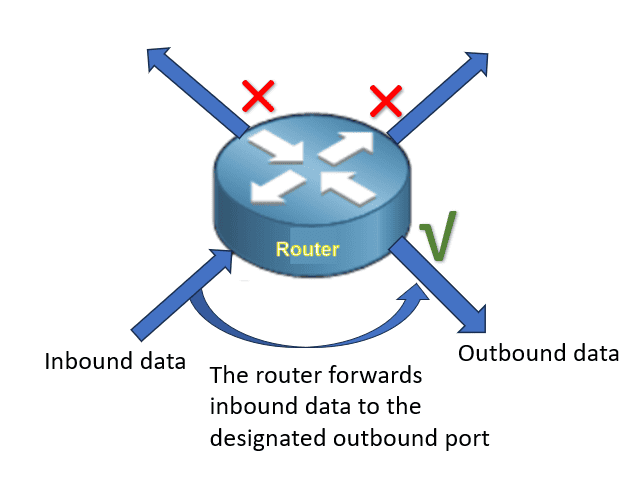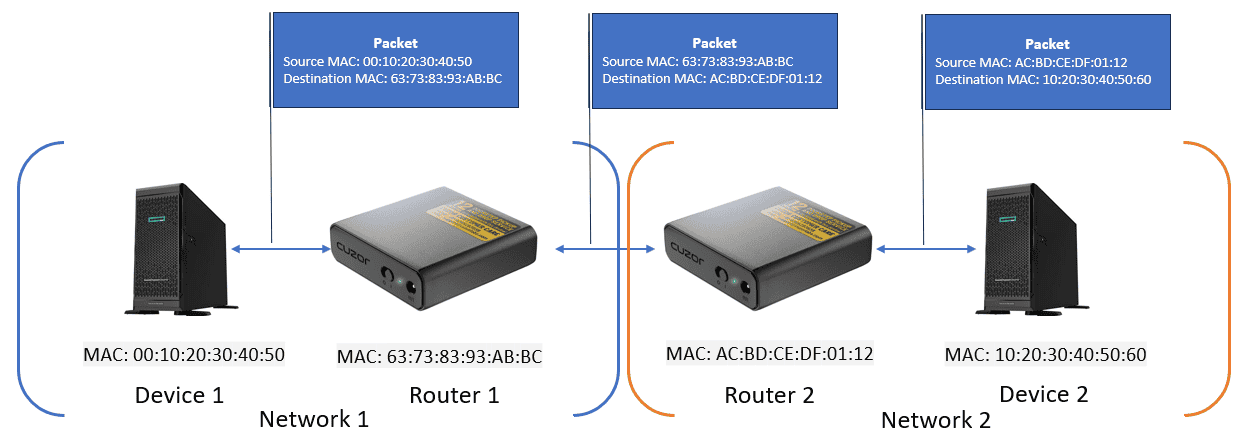1. Introduction
Media Access Control (MAC) addresses are unique identifiers to facilitate communications on physical network segments for Network interface cards (NICs).
A 48-bit hexadecimal MAC address is unique to each network device, including PCs, routers, and smartphones.
In this tutorial, we’ll discuss what happens with MAC addresses during packet forwarding. In addition, we will discuss how a packet’s source and destination MAC address changes during packet forwarding.
2. What Are Routers?
A router is a networking device to control data flow between several networks. They guarantee the safe, effective, and efficient passage of data packets from their source to their destination.
A router determines the best route for Data packets across networks. Routers use routing tables and protocols. to make these choices. Routers divide large networks into smaller subnetworks to improve performance and reduce broadcast traffic.
On a local network, several devices use the same public IP address to access the internet using Network Address Translation (NAT).
Further, to defend the network from threats and unauthorized access, routers employ security mechanisms like firewalls, virtual private networks, and MAC address filtering.
Furthermore, routers control network traffic by prioritizing some data types over others, ensuring that vital applications have enough bandwidth.
3. How Do MAC Addresses and Packet Forwarding Work?
We’ll now discuss the importance of MAC address, and what happens to MAC Addresses during packet forwarding.
3.1. Importance of MAC Addresses in Networking
Local network communication relies heavily on MAC addresses to deliver data safely and quickly to its destination. They guarantee the unique identification of every device connected to a network.
MAC addresses operate on the Data Link Layer of the OSI model. The capability to send and receive frames within the same network segment makes MAC addresses indispensable for local network communication.
Security protocols also use MAC addresses to restrict network access. Switches and routers use MAC address tables to forward data within a local network.
Address Resolution Protocol (ARP) maps IP addresses to MAC addresses so that devices on a local network can find each other.
MAC addresses help a network administrator track and regulate network activity. Furthermore, they are used for intrusion detection and network analysis to identify and track devices.
Finally, MAC addresses are used to identify the precise device creating an issue while diagnosing network problems.
3.2. Packet Forwarding
Network devices such as switches and routers use packet-forwarding mechanisms to route data packets from source to destination. The packet forwarding process involves the following steps:
- Source device sends packet: a device packs its source and destination MAC addresses into a packet
- Changes the forward frames: switches maintain a table of MAC addresses and associated particular port
- The switch forwards a frame: to the correct port after verifying the destination MAC address
- Router Forwarding: routers forward packets between networks when they need to go from one network to the other network using IP addresses
- MAC Address Modifications: the router modifies the source MAC address to its own MAC address and the destination MAC address to the MAC address of the next hop as a packet travels from one network to another
The following figure shows a schematic diagram of packet forwarding by a router:

Although a router may have several ports to forward, it selects the best suitable port to forward the packet.
4. How Do Routers Handle MAC Addresses?
We’ll explain router behavior with MAC Addresses. Routers are essential to guide data packets between various networks. Let’s discuss how they manage MAC addresses throughout this process.
Upon receiving a packet, a router examines the destination MAC address. The router continues processing the packet if the destination MAC address matches its interface.
Further, the router decapsulates the packet to obtain the IP header. The router then finds the optimal way to forward the packet to its destination by using the destination IP address in its routing decision.
Furthermore, MAC address tables (or ARP tables) that map IP addresses to MAC addresses are part of the router’s monitoring. This table determines the correct MAC address for the next hop.
The router modifies the packet’s source and destination MAC addresses before forwarding it to the next network segment.
If the router is unsure of the MAC address of the upcoming hop, it uses ARP to resolve the IP address to a MAC address. The device with the matching IP address replies to the router’s ARP request with its MAC address, which the router uses to update its MAC address table.
The router encapsulates the packet with the updated MAC addresses and forwards it to the subsequent hop after updating the MAC addresses. This procedure continues until the packet reaches its destination.
5. Examples
We’ll explain MAC Address changes in different scenarios. The following figure illustrates the router packet forwarding across different networks:

When a router forwards a packet from one network to another, the router’s MAC address becomes the source MAC address of the packet.
Further, the destination MAC address changes to the MAC address of the next hop (subsequent router or the final target device).
Before sending the packet to the external network in a NAT scenario, the router adjusts the source IP address and assigns the source MAC address to its own MAC address.
When switching within the same network, switches forward packets using the MAC address table rather than changing their MAC addresses. The switch may append a VLAN ID to a packet if it forwards it to a separate VLAN.
Additionally, before sending a packet to the wireless client from a wired network, the wireless access point (WAP) may alter the packet’s source MAC address to match its own.
5.1. Comparison of Packet Forwarding Scenarios
The following table shows the contrast among the different scenarios of packet forwarding:
Feature/ Functionality
Router Forwarding Packets Between Networks
Network Address Translation (NAT)
Switching Within the Same Network
Wireless Access Points (WAP)
Primary Function
Directs data packets between different networks
Translates private IP addresses to public IP addresses
Connects devices within the same network
Provides wireless network access
Layer of OSI Model
Network Layer (Layer 3)
Network Layer (Layer 3)
Data Link Layer (Layer 2)
Data Link Layer (Layer 2)
Device Type
Router
Router/Firewall
Switch
Access Point
Key Protocols
IP, ICMP, BGP, OSPF
NAT, PAT
Ethernet, VLAN
Wi-Fi (802.11 standards)
Use Case
Connecting different networks (e.g., LAN to WAN)
Allowing multiple devices to share a single public IP address
Connecting devices within the same LAN
Providing wireless connectivity to devices
Security Features
Can include firewalls and VPN support
Hides internal IP addresses
May include VLANs for segmentation
WPA2/WPA3 encryption
Performance Impact
Can introduce latency due to routing decisions
Minimal impact, but can affect performance if overloaded
Generally low latency
Dependent on signal strength and interference
Configuration Complexity
Moderate to high
Moderate
Low to moderate
Low to moderate
Scalability
High, suitable for large networks
High, but depends on the number of devices
High, suitable for large networks
Moderate, depends on coverage area
6. What Are the Practical Implications?
Packet forwarding has various practical implications in networking. It involves efficient data packet transmission across networks from source to destination, which is required for Internet and intranet communications to function effectively and reliably.
A packet forwarding technique helps manage large and complex networks. It uses methods such as the next-hop and network-specific.
Data traffic and devices are rapidly growing, so scalability is crucial. Network traffic spreads evenly over multiple paths due to packet forwarding by routers and switches. This capability improves overall network performance as no single path becomes overloaded.
Various security measures, such as filtering and network monitoring are part of packet forwarding. The network is thus more secure because it can detect and prevent unauthorized access and malicious activities.
Packet forwarding mechanisms can prioritize certain types of traffic, ensuring critical applications receive the necessary bandwidth and low latency. Real-time applications like VoIP and video conferencing require this in particular.
For redundancy, networks can use several pathways for packet forwarding. This approach ensures network resilience, and even in the event of a path failure, the data will still reach the destination via an alternate path.
7. Conclusion
In this article, we explored why packet forwarding plays a crucial role in networking by guaranteeing dependable and effective data transfer across networks. This method relies heavily on MAC addresses since they allow switches to accurately forward packets based on the unique identification of devices within a local network.
Further, to forward packets to the appropriate next-hop device, routers manage MAC addresses by resolving them using ARP. Packet forwarding has countless practical applications like guaranteed Quality of Service and network resiliency.
Additionally, it improves network scalability, load balancing, and security. The routers and MAC addresses cooperate in packet forwarding for an effective data transfer.